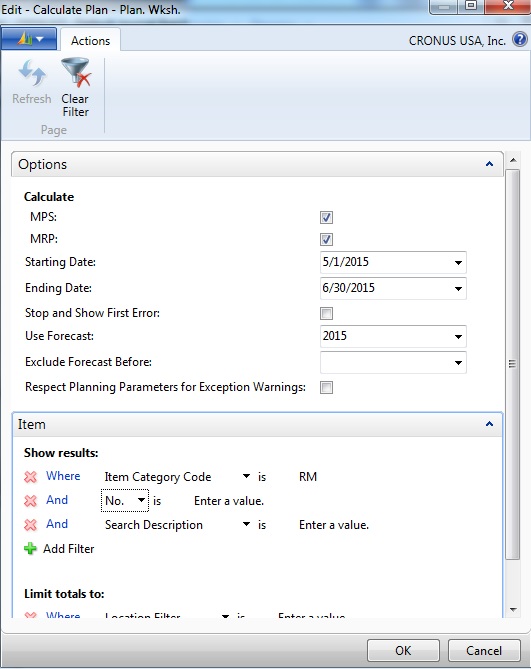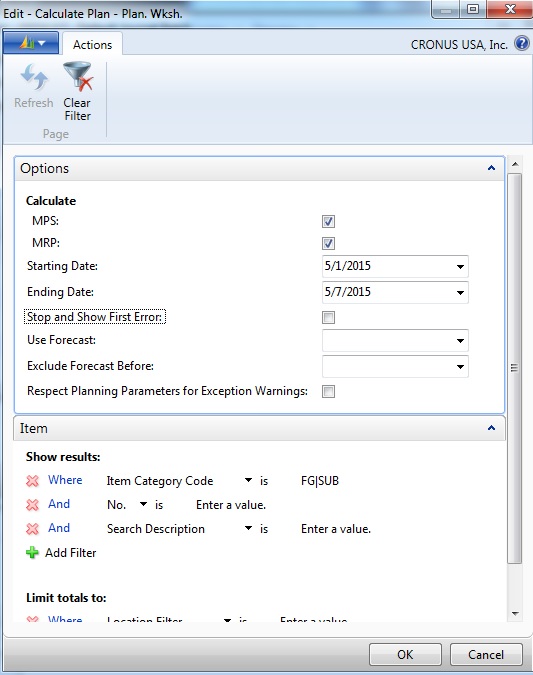Overview
On the previous article about Dynamics NAV Manufacturing planning, we discussed about setting up your items to calculate the MPS requirements based on the sales forecast. With the MPS, it allows us to create what raw materials we need to purchase for the months to come.
As emphasized in the previous article, every company makes purchase orders out of some type of sales forecast. For almost every industry, forecasting is an art, not a science.
Planning What You’re Going to Buy
After the Planned Production Orders (PPO) are created for the Finished Goods (FG) and Sub-assemblies (SUB), we will be able to start making purchase orders for raw materials based on the demands from these Planned Production Orders.
To do this, you will need to go to the Planning Worksheet and run the Calculate Regenerative Plan. Put our Starting Date and Ending Date 60 days out or whatever you’re lead time is for your raw material item. This will capture everything you need to purchase now in order to fulfill the raw material requirements. We will also want to run our planning for items that’s categorized as Raw Materials (RM). Since we did not enter in the forecast numbers into our Sales Forecast (we forecast on the finished goods that drives the raw materials), it really doesn’t matter if you include forecast or not.

When the planning worksheet is populated, depending on your settings on the Replenishment and Planning FastTab, it will recommend the purchase orders you need to create by a certain date.
NOTE: Setting the Replenishment and the Planning FastTabs on the item card is an art/science of its own. This will be a good topic for a separate blog article.
The Weekly or <Insert your production cycle> Manufacturing Plan
The weekly plan should be ran based on the actual sales orders that are requiring the goods. Every day, your company will receive sales orders for your manufactured goods. Your items typically have some lead time, either 1 day or 3 days or whatever days. We will use the planning worksheet to calculate all the sub assemblies and finished goods we need to make to satisfy the sales orders.
When you run your Planning Worksheet, click on Calculate Regenerative Plan. Set your Starting Date and Ending Date to 1 week. Make sure the Use Forecast is left blank. The reason is because we are no long using forecast to build our finished goods. We’re only building what we need to ship.

After the production manager reviews the suggestions made by the planning worksheet, he or she will create a Firm Planned Production Order (FPPO). From the FPPO, each FPPO can be released to the production floor as needed.
Some companies run the weekly plan every day to incorporate any changes in their actual demand. I suspect you will need to have an internal meeting to figure out what makes sense.
NOTE: When you run your weekly (or your production cycle) plan in the planning worksheet, it will delete any outstanding Planning Production Orders. So make sure to re-calculate the regenerative plan based on the forecast when you need to make new or change purchase requirements.
Conclusion
Based on the above scenario, there are 2 basically objectives:
1. Create the production order so your orders can be shipped as soon as possible
2. Have enough raw materials in your warehouse so you can make what you need to ship
Essentially, assuming the above setup, you have to run these 3 steps for planning
1. Calculate the FG items first and carry out action message either as Planned Production Order (PPO) or Firm Planned Production Order (FPO)
2. Calculate the SUB items afterwards and carry out action message eithe as Planned Production Order (PPO) or Firm Planned Production Order (FPO)
3. Buyers calculate buying plan for RM items based on the FG and the SUB items that are created in the PPO.

Waiting for: “Setting the Replenishment and the Planning FastTabs on the item card is an art/science of its own” 😀
I can write a blog about this on what we typically is set for our customers. But it really depends on the business and how they do their inventory planning.
For the daily update of the plan why not run just the Net Change function rather than a full regen? Its a lot fast a will reflect any changes you need to take account of.
You could, The problem I have with running just net change is that it does not take account into new items that may be required. This is why I typically run full regen to make sure I grab everything.
When calculating regenerative plan for production orders, will this ever delete existing production orders?
I ask this because we use a 3rd party planning tool to fine tune the schedule. If the production order was deleted and recreated under a different number then the 3rd party schedule would loose data and need to be re-scheduled.
If the regenerative planning does delete production orders, would these only be planned production orders?
The regenerative plan only deletes the Planned Production Orders.
If the status has been changed to Firm Planned or Released, it will show up on the Planning Worksheet with the Action Type of Cancel.
Client has created a customization that will display linked sales order to the production order when planned through sales order. Does this affect if the order rel prod order will get picked up in the planning worksheet?
How would you use the “order planning” functionality in NAV 2009. I almost like that view better than the planning worksheet.
Thanks.
Order Planning is often used in Make to Order companies where you need to plan the parts for a specific order, not based on any forecast or plans. Depending on how your company operates, those are really 2 separate functionalities.
If the values did not change, then yes, everything you do in NAV regarding inventory orders will get picked up by the planning worksheet.
I have a case in NAV 2013 as follows.
The configuration is:
Item A, Replenishment System – Manufacturing, Manufacturing policy – Make to order
Item B, Replenishment System – Manufacturing, Manufacturing policy – Make to order
Item B is component for Item A.
When I generate demand for item A, and then calculate regenerative planning in planning worksheet for Item A|B only, system is suggesting two different order numbers for both items.
Same case I am doing in NAV 2009R2, NAV 2013R2, when i run the planning w/s for Item A|B only systems suggests single order for both items and creates two lines in that order.
But this is not happening in NAV 2013.
Can you please help me out?
I found a Application hotfix but it is for DE localization, will this work for IN localization?
Like you said, just apply the hotfixes and it’ll be resolved. Why wouldn’t the hotfix work for the IN localization?
Hi Alex,
We deal with two sites. The main site, Site A, manufacturers FG and Subs, and also purchases raw material. The second site, Site B, is mainly replenished with transfer orders from Site A.
I like your recommendation to create production orders first for FG and SUB, then create purchase orders for RM. However, it’s gets tricky with transfer orders in the mix. I’m finding that Transfer Order is not an available filter in the Calculate Plan window.
My only solution is to run the Planning Worksheet for all items, but only carry-out production order messages. Then, I will re-run the plan and carry out actions for transfers and purchases. Does this sound good to you?
Thanks,
Steve
Yes, the latter can be ran using the Requisition Worksheet.
For some of our customers, the planning worksheet is strictly for planning production orders. If the planning worksheet suggests purchases and transfer, they are copied to the Requisition Worksheet for the transporting/purchasing department to approve.
is there any option to learn production planning in NAV for beginners?
There’s a portal called Dynamics Learning Portal that may help you.
Pingback: Planning for Dynamics NAV in Manufacturing Environment (2/2) – Confessions of a Dynamics 365 Business Central Consultant – Thinking Enterprise Solutions https://www.vizorsol.com